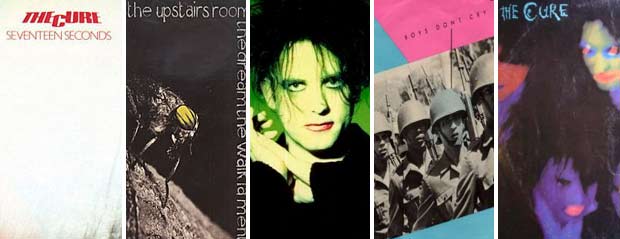
Want to feel old? Chew on this: the Cure got their first record deal 30 years ago this September. Where’s my walker? Fortunately, band leader Robert Smith isn’t showing his age, and in anticipation of the band’s forthcoming (as yet untitled) 13th album, they’re releasing a single every month this summer. The latest installment, “Sleep When I’m Dead” (below) is a rerecording of a rejected track from the 1985 Head on the Door sessions, and it has that era’s quirky, jaunty feel, like a darker “Let’s Go to Bed.”
Back in the day, it seemed like the Cure could do no wrong: even B-sides and obscure album tracks were amazing. After the jump: five great Cure songs that never made it to the hit parade.
1. “The Upstairs Room” (from The Walk EP, 1983)
A hypnotic balance of robotic synth-pop and aggressive, angular guitar work, “Upstairs Room” also features Robert Smith at his most sassy: after declaring he couldn’t love “anyone but you” he adds a biting “dear,” and then, just to make it clear, deadpans “that’s for sure.”
2. “M” (from Seventeen Seconds, 1980)
Even though this song has the bare-bones production typical of the era, its swooshing cymbal and extended coda offer tantalizing hints at the band’s future. Plus, what better mantra for the ’80s club scene is there but “you’ll fall in love with somebody else again tonight”?
3. “Like Cockatoos” (from Kiss Me Kiss Me Kiss Me, 1987)
Another track that sounds better in retrospect, “Cockatoos” is easily overlooked on the sprawling, 17-track Kiss Me, but its swirling production and Eastern tones point directly towards the 1989 masterpiece Disintegration.
4. “Plastic Passion” (from “Boys Don’t Cry” single, 1979)
While the lyrics don’t really make any sense (are they talking about credit cards?) the track’s propulsive, new-wave energy make it a worthy B-side to “Boys Don’t Cry,” and there’s almost a taste of “Close to Me” in its double-time beat.
5. “Sinking” (from Head on the Door, 1985)
Sure, Head on the Door isn’t exactly obscure, but “Sinking” is almost lost amongst the towering hits like “Inbetween Days” and “Close to Me.” It may be the 8th best song on the album (just ahead of “Screw” and “The Baby Screams,” in my humble opinion), but it presages the epic turn the band would soon take.











